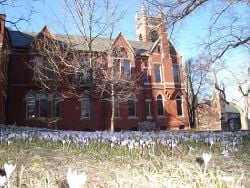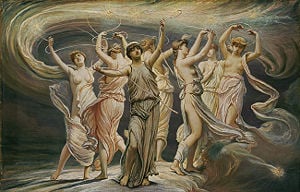| Seven Sisters | |
|---|---|
| Data | |
| Established | 1927 |
| Continent | North America |
| Country | United States |
| University type | Private women's liberal arts colleges |
The Seven Sisters are seven highly prestigious, historically women's private liberal arts colleges in the Northeastern United States. The consortium traces its origins to a conference at Vassar College in 1915 to discuss ways to increase revenues. Subsequent conferences led to the name "Seven Sisters" being associated with the group. Their common efforts have expanded beyond fund-raising to include admissions requirements, academic standards, and common goals. The overriding goal originally was naturally to provide the best higher education for women. While for five of the colleges this is still a defining characteristic and significant goal, two of them, Radcliffe (which merged with Harvard College) and Vassar (which became coeducational in 1969), are no longer women's colleges. Nevertheless, the term "Seven Sisters" and the collegiality of the colleges continues to inspire and encourage young women to pursue excellence in their education and subsequent careers.
Seven sister colleges
The Seven Sisters are seven historically women's liberal arts colleges in the Northeastern United States. They are Barnard College, Bryn Mawr College, Mount Holyoke College, Radcliffe College, Smith College, Wellesley College, and Vassar College. They were all founded between 1837 and 1889. Four are in Massachusetts, two are in New York, and one is in Pennsylvania.
| Institution | Location | School type | Full-time enrollment | Opened door to students | Collegiate Charter |
|---|---|---|---|---|---|
| Mount Holyoke College/originally Mount Holyoke Female Seminary | South Hadley, Massachusetts | Private women's college | 2,100 | 1837 | 1888 |
| Vassar College | Poughkeepsie, New York | Private coeducational | 2,400 | 1861 | 1861 |
| Wellesley College | Wellesley, Massachusetts | Private women's college | 2,300 | 1875 | 1870 |
| Smith College | Northampton, Massachusetts | Private women's college | 2,750 | 1875 | 1871 |
| Radcliffe College/originally The Harvard Annex | Cambridge, Massachusetts | Radcliffe Institute for Advanced Study (no longer accepts students) | n/a | 1879 | 1894 |
| Bryn Mawr College | Bryn Mawr, Pennsylvania | Private women's college | 1,229 | 1885 | 1885 |
| Barnard College | Morningside Heights, Manhattan, New York | Private women's college | 2,356 | 1889 | 1889 |
History
Background
In Women's Colleges in the United States: History, Issues, and Challenges, Irene Harwarth, Mindi Maline, and Elizabeth DeBra note that "Independent nonprofit women’s colleges, which included the 'Seven Sisters' and other similar institutions, were founded to provide educational opportunities to women equal to those available to men and were geared toward women who wanted to study the liberal arts".[1] The colleges also offered broader opportunities in academia to women, hiring many female faculty members and administrators.
Early proponents of education for women were Sarah Pierce (Litchfield Female Academy, 1792); Catharine Beecher (Hartford Female Seminary, 1823); Zilpah P. Grant Banister (Ipswich Female Seminary, 1828); and Mary Lyon. Lyon was involved in the development of both Hartford Female Seminary and Ipswich Female Seminary. She also helped establish Wheaton Female Seminary (now Wheaton College, Massachusetts) in 1834. In 1837, Lyon founded Mount Holyoke Female Seminary (Mount Holyoke College), the "first of the Seven Sisters."[2] Mount Holyoke received its collegiate charter in 1888 and became Mount Holyoke Seminary and College. It became Mount Holyoke College in 1893. Harwarth, Maline, and DeBra note that, "Mount Holyoke’s significance is that it became a model for a multitude of other women’s colleges throughout the country."[1] Both Vassar College and Wellesley College were patterned after Mount Holyoke.[3] Vassar was the first of the Seven Sisters to be chartered as a college in 1861.
Wellesley College was chartered in 1870 as the Wellesley Female Seminary and was renamed Wellesley College in 1873. It opened its doors to students in 1875. Radcliffe College was originally created in 1879 as The Harvard Annex for women's instruction by Harvard faculty. It was chartered as Radcliffe College by the Commonwealth of Massachusetts in 1894. Barnard College became affiliated with Columbia University in 1900, but it continues to be independently governed. Smith College was chartered in 1871 and opened its doors in 1875. Bryn Mawr opened in 1885.
Mount Holyoke College and Smith College are also members of Pioneer Valley's Five Colleges consortium, which also includes Amherst College, Hampshire College, and University of Massachusetts Amherst. Bryn Mawr College is a part of the Tri-College Consortium in suburban Philadelphia, with its sister schools, Haverford College and Swarthmore College.
Formation and name
Harwarth, Maline, and DeBra state that "the 'Seven Sisters' was the name given to Barnard, Smith, Mount Holyoke, Vassar, Bryn Mawr, Wellesley, and Radcliffe, because of their parallel to the Ivy League men’s colleges" in 1927.[1]
The name, Seven Sisters, is a reference to the Greek myth of The Pleiades (mythology), the seven daughters of the Titan Atlas and the sea-nymph Pleione. The daughters were collectively referred to as The Seven Sisters and included Maia, Electra, Taygete, Alcyone, Celaeno, Sterope, and Merope. In the field of astronomy, a cluster of stars in the constellation Taurus is also referred to as The Pleiades (star cluster) or the Seven Sisters.
Late twentieth century
Beginning in 1963, students at Radcliffe received Harvard diplomas signed by the presidents of Radcliffe and Harvard. Joint commencement exercises began in 1970, and several Harvard and Radcliffe dormitories began exchanging students experimentally. In 1972, full co-residence was instituted, and the departments of athletics of both schools merged shortly thereafter. In 1977, Harvard and Radcliffe signed an agreement which put undergraduate women entirely in Harvard College. In 1999, Radcliffe College was dissolved and Harvard University assumed full responsibility over the affairs of female undergraduates. Radcliffe is now the Radcliffe Institute for Advanced Study in Women's Studies at Harvard University.
Vassar College declined an offer to merge with Yale University and instead became coeducational in 1969.
Mount Holyoke College engaged in a lengthy debate under the presidency of David Truman over the issue of coeducation. On November 6, 1971, "after reviewing an exhaustive study on coeducation, the board of trustees decided unanimously that Mount Holyoke should remain a women's college, and a group of faculty was charged with recommending curricular changes that would support the decision."[4]
Smith College also made a similar decision in 1971.[5]
In 1969, Bryn Mawr College and Haverford College (then all-male) developed a system of sharing residential colleges. When Haverford became coeducational in 1980, Bryn Mawr discussed the possibly of coeducation as well but decided against it.[6]
In 1983, Columbia University began admitting women after a decade of failed negotiations with Barnard College for a merger along the lines of Harvard and Radcliffe (Barnard has been affiliated with Columbia since 1900, but it continues to be independently governed).
Wellesley College also decided against coeducation during this time.
Notes
- ↑ 1.0 1.1 1.2 Irene Harwarth, Women's Colleges in the United States: History, Issues, and Challenges (Diane Pub Co., 1997, ISBN 978-0788143243).
- ↑ About Mount Holyoke mountholyoke.edu. Retrieved September 10, 2015.
- ↑ Jennifer L. Crispen, Seven Sisters and a Country Cousin sbc.edu. Retrieved September 10, 2015.
- ↑ Mount Holyoke:A Detailed History mtholyoke.edu. Retrieved September 10, 2015.
- ↑ Smith College Presidents smith.edu. Retrieved September 10, 2015.
- ↑ A Brief history of Bryn Mawr College brynmawr.edu. Retrieved September 10, 2015.
ReferencesISBN links support NWE through referral fees
- Creighton, Joanne V. A Tradition of Their Own: Or, If a Woman Can Now Be President of Harvard, Why Do We Still Need Women’s Colleges? June 1, 2007.
- Greene, Howard, and Mathew W. Greene. Greenes' Guides to Educational Planning: The Hidden Ivies: Thirty Colleges of Excellence. New York, NY: HarperCollins, 2000. ISBN 0060953624
- Harwarth, Irene. Women's Colleges in the United States: History, Issues, and Challenges. Diane Pub Co., 1997. ISBN 978-0788143243
- Horowitz, Helen Lefkowitz. Alma Mater: Design and Experience in the Women's Colleges from Their Nineteenth-Century Beginnings to the 1930s. Amherst, MA: University of Massachusetts Press, 1993 (2nd edition). ISBN 978-0870238697
- Perkins, Linda M. "The Racial Integration of the Seven Sister Colleges". Journal of Blacks in Higher Education Spring, 1998, 104–108.
External links
All links retrieved January 26, 2023.
- Seven Sisters - Encyclopædia Britannica
- Seven Sisters and a Country Cousin
Credits
New World Encyclopedia writers and editors rewrote and completed the Wikipedia article in accordance with New World Encyclopedia standards. This article abides by terms of the Creative Commons CC-by-sa 3.0 License (CC-by-sa), which may be used and disseminated with proper attribution. Credit is due under the terms of this license that can reference both the New World Encyclopedia contributors and the selfless volunteer contributors of the Wikimedia Foundation. To cite this article click here for a list of acceptable citing formats.The history of earlier contributions by wikipedians is accessible to researchers here:
The history of this article since it was imported to New World Encyclopedia:
Note: Some restrictions may apply to use of individual images which are separately licensed.

